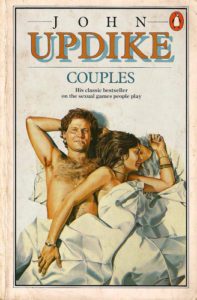 Ellen Feldman offers “A Brief Literary History of Birth Control from George Orwell and John Updike to Grace Metalious and Alice Munro” in an article posted 23 March 2017 at Literary Hub. The entry on Updike credits Rabbit, Run as a touchstone:
Ellen Feldman offers “A Brief Literary History of Birth Control from George Orwell and John Updike to Grace Metalious and Alice Munro” in an article posted 23 March 2017 at Literary Hub. The entry on Updike credits Rabbit, Run as a touchstone:
“Rabbit Angstrom of John Updike’s Rabbit, Run, has an aversion to contraception, but unlike Orwell’s character, he objects to it on physical and aesthetic rather than political grounds. When Ruth Leonard, the ‘hooer’ to whom he’s giving fifteen dollars ‘toward [her] rent,’ is about to slip into the bathroom to insert what he calls a ‘flying saucer,’ he stops her with the argument that he’s ‘very sensitive.’ ‘Do you have the answer then?’ she asks. ‘No, I hate them even worse…If you’re going to put a lot of gadgets in this,’ Rabbit, who has abandoned his pregnant wife and child, goes on, ‘give me the fifteen back.’
Couples is also cited: “Eight years after the publication of Rabbit, Run, Updike not only espoused birth control but also identified it by brand name. The first time Piet and Georgene, married to other people, have sex, he worries about ‘making a little baby,” and she’s surprised he doesn’t know about Enovid. ‘Welcome to the post-pill paradise,’ she tells him, and the ‘light-hearted blasphemy . . . immensely relieved him.'”
With only nine entries you’d have to call it a very brief history, but it’s still a fascinating round-up.
